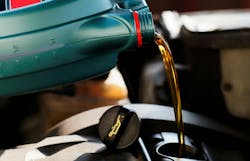Engine Oils 101: Understanding viscosity grades and when to use them
Savvy fleet maintenance managers seek the most modern engine oil formulations that meet today’s engine performance requirements while also allowing them to push the envelope with respect to fuel economy. Finding the right balance largely comes down to choosing the right viscosity grade for the vehicle and application at hand.
What do these oil viscosity grades mean?
Let’s use 15W-40 as an example. The 15W relates to how well the oil flows at lower temperatures. An easy way to remember this is that the “W” stands for winter. The “40,” then, relates to how well the oil flows at normal temperatures.
The lower the number (viscosity), the more freely the oil flows. Thus, a 5W-40 will flow more freely at cold temperatures than a 10W-40. A 10W-30 will flow more freely at both lower and normal temperatures than a 15W-40.
The upside of a lower-viscosity, more free-flowing oil is that there is less friction in the engine. That results in less energy use, which improves fuel economy. But there can be a trade-off.
“In some duty cycles, running a lower viscosity may result in engine component wear,” said Andrew Martin, technical manager at U.S. Lubricants, a supplier to automotive dealerships, repair shops, lube shops and tire centers, as well as commercial fleets. “A thicker oil (i.e., 15W-40) provides more protection to the engine under load and during start/stop cycles common in city delivery.”
Read more: PC-12: Last of the HD engine oils?
U.S. Lubricants’ product offering includes their own brand Thrive as well as Castrol, Valvoline, and Motorcraft.
For fleets, understanding viscosity is important because an engine can operate with more than one viscosity grade. Case in point, Chevron Lubricants' product page states that fleets can filter oils by equipment type. Here’s a quick summary of the engine oil viscosity grades Chevron recommends for different truck types:
· Pickup truck: synthetic blend 5W-20, 5W-30, or 10W-30
· Medium- and heavy-duty on-highway trucks: full synthetic 15W-40, synthetic blend 10W-30, or full synthetic 5W-40 for severe-duty applications and wider range of climates
· On-highway vocational vehicles: synthetic blend 10W-30
Is the oil formulated for maximum protection?
Synthetic and synthetic blends have become fairly common among fleets.
“The use of synthetic base oils in a lubricant helps to improve the usable life of the engine oil by improving the oxidation and thermal stability of the lubricant but will also improve other characteristics like cold-temperature operability,” Martin explained.
Another thing to look for is an engine oil that leverages the latest formulations that satisfy the requirements of today’s engines. This is where the American Petroleum Institute’s engine oil certifications come into play. API’s two most recent diesel engine oil categories, for example, are CK-4 and FA-4.
CK-4 oils, which are typically backwards-compatible when an older CJ-4 is recommended, are carefully formulated to provide enhanced protection against oil oxidation, viscosity loss due to shear, oil aeration, catalyst poisoning, DPF blocking, engine wear, piston deposits, degradation of low- and high-temperature properties, and soot-related viscosity increase. They are most commonly available as either a 15W-40 or lower-viscosity 10W-30.
FA-4 oils, which are only available for use in select MY2017 and newer vehicles, are typically available as a 10W-30 or 5W-30. They are formulated to provide the same enhanced protection characteristics as CK-4 oils but really push the envelope when it comes to lower viscosity and fuel efficiency.
API will release the PC-12 update in 2027 to replace CK-4 and FA-4 to align with the new NOx emissions regulations issued by the Environmental Protection Agency.
Other examples of oil viscosity recommendations
For Detroit diesel engines, refer to Specification 93K222 for CK-4 oil, which lists approved engine oils in 10W-30 and 15W-40, as well as 5W-30, 5W-40, and 10W-40. Detroit Specification 93K223 for FA-4 oils lists engine oils in 10W-30 and 5W-30 that have been approved.
The Cummins L9 engine, a common option on many medium-duty trucks, is best served by a 10W-30 or 15W-40 under normal operating conditions. For areas with colder temperatures, other grades may be necessary, perhaps a 5W-30 or 10W-40. With the Cummins X15 engine for heavy-duty trucks, a 15W-40 or 10W-30 is authorized.
Paccar MX-11 and MX-13 engines are found on several heavy-duty trucks. A 10W-30 (CK-4) is recommended for normal operating conditions, although several other CK-4 grades are also authorized: 5W-30, 15W-40, and 5W-40. In addition, the company says a 10W-40 could be used in either a CK-4 or CJ-4.
With its PX-9 engine, which is used in both medium- and heavy-duty applications, Paccar recommends a 10W-30 (CK-4 or CJ-4) for normal operation at ambient temperatures above 5°F. When it’s below 5°F, a 5W-40 is authorized. In environments where the temperature never exceeds 32°F, 0W-30 and 0W-40 synthetic oils can be used. For severe-duty applications, Paccar recommends a higher-viscosity 15W-40 for maximum protection.
In looking at some of the smaller truck classes, such as the Ford 2024 Super Duty F-450 XLT, Ford recommends using a 10W-30 or possibly a 0W-40 in extremely cold environments of -22°F. Additionally, Ford recommends a 5W-40 for severe-duty service.
Light-duty vans have their own set of oil recommendations. Take a Mercedes-Benz Sprinter Van, for example. The company recommends a 5W-40 for a gasoline engine and a 5W-30 for diesel.
These are just a few examples of the many commercial vehicles and engines that are out there. But these examples help paint a picture of which engine oil viscosity grades tend to make more sense in certain situations. In severe-duty applications, 40-weights typically get the nod for their enhanced protection at normal operating temperatures. In really cold environments, 5W or even 0W oils start to make sense. And for fleets looking to strike the right balance between engine protection and fuel economy, 10W-30s are becoming increasingly popular for medium- and heavy-duty diesel engines.
As always, it’s important to refer to your specific engine owner’s manual for information on which oil grade is recommended. If you have options, understanding how viscosity grades work can help you make the right selections.
About the Author

Gregg Wartgow
Gregg Wartgow is a freelancer who Fleet Maintenance has relied upon for many years, writing about virtually any trucking topic. He lives in Brodhead, Wisconsin.
